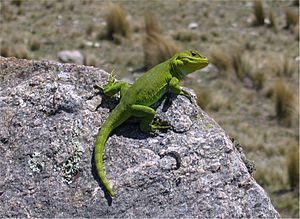Argentine anole facts for kids
Quick facts for kids Argentine anole |
|
|---|---|
 |
|
| Conservation status | |
| Scientific classification | |
| Genus: |
Pristidactylus
|
| Species: |
achalensis
|
The Pristidactylus achalensis, also known as the Argentine anole, is a fascinating type of lizard. It belongs to the family Leiosauridae. This special lizard is found only in Argentina, meaning it is endemic to that country. It was first described by a scientist named José María Alfonso Félix Gallardo in 1964.
Contents
Discovering the Argentine Anole
The Argentine anole is a unique reptile that lives in the beautiful landscapes of Argentina. Scientists first officially described this species in 1964. This means that year, it was given its scientific name, Pristidactylus achalensis. The name helps researchers around the world identify and study this specific lizard.
Where Does It Live?
This lizard calls the mountainous regions of Argentina home. It prefers areas with rocky terrain and some plant cover. These habitats provide good places for the lizards to hide from predators and find food. They are often found in places like the Sierra de Achala, which is a mountain range in central Argentina.
What Does It Look Like?
Argentine anoles are medium-sized lizards. They usually have a slender body and a long tail. Their skin color can vary, often blending in with their surroundings. This helps them stay hidden from animals that might want to eat them. Like many lizards, they have sharp claws that help them climb rocks and trees.
What Do They Eat?
These lizards are mostly insectivores, meaning they love to eat insects. Their diet can include various small bugs, spiders, and other invertebrates they find in their habitat. They are active hunters, using their quick movements to catch their prey.
How Do They Behave?
Argentine anoles are diurnal, which means they are active during the daytime. You might see them basking in the sun on rocks to warm up their bodies. This is a common behavior for reptiles, as they rely on external heat to regulate their body temperature. They are also quite agile and can move quickly when needed.
Conservation Status
The conservation status of the Argentine anole is currently listed as "Near Threatened" (NT) by the IUCN (International Union for Conservation of Nature). This means that while it's not critically endangered right now, its population might be at risk in the future. Protecting their natural habitat is very important to ensure these unique lizards continue to thrive.
See also
- In Spanish: Lagarto verde de Achala para niños


